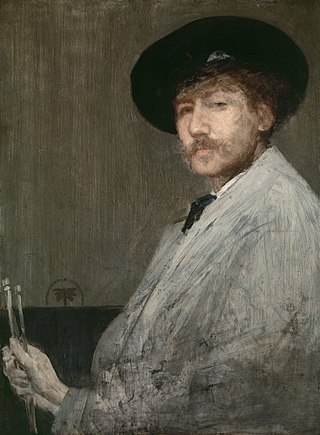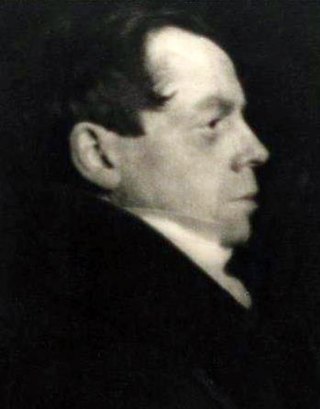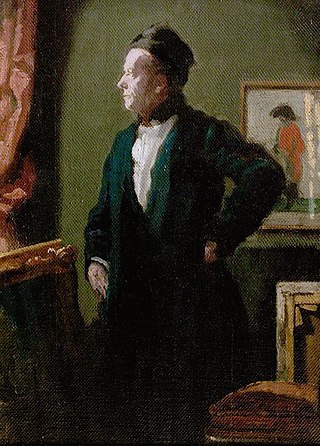
James Abbott McNeill Whistler was an American painter in oils and watercolor, and printmaker, active during the American Gilded Age and based primarily in the United Kingdom. He eschewed sentimentality and moral allusion in painting and was a leading proponent of the credo "art for art's sake".

Sir John Everett Millais, 1st Baronet was an English painter and illustrator who was one of the founders of the Pre-Raphaelite Brotherhood. He was a child prodigy who, aged eleven, became the youngest student to enter the Royal Academy Schools. The Pre-Raphaelite Brotherhood was founded at his family home in London, at 83 Gower Street. Millais became the most famous exponent of the style, his painting Christ in the House of His Parents (1849–50) generating considerable controversy, and he produced a picture that could serve as the embodiment of the historical and naturalist focus of the group, Ophelia, in 1851–52.

Sir Edward Coley Burne-Jones, 1st Baronet, was an English painter and designer associated with the Pre-Raphaelite Brotherhood's style and subject matter.

Alphonse Legros was a French, later British, painter, etcher, sculptor, and medallist. He moved to London in 1863 and later was naturalized as British. He was important as a teacher in the British etching revival.

Sir William Newzam Prior Nicholson was a British painter of still-life, landscape and portraits. He also worked as a printmaker in techniques including woodcut, wood-engraving and lithography, as an illustrator, as an author of children's books and as a designer for the theatre.

James Ferrier Pryde was a British artist. A number of his paintings are in public collections, but there have been few exhibitions of his work. He is principally remembered as one of the Beggarstaffs, his artistic partnership with William Nicholson, and for the poster designs and other graphic work they made between 1893 and 1899, which influenced graphic design for many years.

John Christopher "Kit" Wood was an English painter born in Knowsley, near Liverpool.

Sir Alan Bowness CBE was a British art historian, art critic, and museum director. He was the director of the Tate Gallery between 1980 and 1988.

Tate Britain, known from 1897 to 1932 as the National Gallery of British Art and from 1932 to 2000 as the Tate Gallery, is an art museum on Millbank in the City of Westminster in London, England. It is part of the Tate network of galleries in England, with Tate Modern, Tate Liverpool and Tate St Ives. Founded by Sir Henry Tate, it houses a substantial collection of the art of the United Kingdom since Tudor times, and in particular has large holdings of the works of J. M. W. Turner, who bequeathed all his own collection to the nation. It is one of the largest museums in the country. The museum had 525,144 visitors in 2021, an increase of 34 percent from 2020 but still well below pre- COVID-19 pandemic levels. In 2021 it ranked 50th on the list of most-visited art museums in the world.

Louise Jane Jopling was an English painter of the Victorian era, and one of the most prominent female artists of her generation.

Completed in 1871, Nocturne: Blue and Silver – Chelsea is a painting by James McNeill Whistler. It is the earliest of the London Nocturnes and was conceived on the same August evening as Variations in Violet and Green. The two paintings were exhibited together at the Dudley Gallery.

Elizabeth Adela Forbes was a Canadian painter who was primarily active in the UK. She often featured children in her paintings and School Is Out is one of her most popular works. She was friends with the artists James Abbott McNeill Whistler and Walter Sickert, both of whom influenced her work. Her etchings in particular are said to show the influence of Whistler.

Eileen Forrester Agar was an Argentine-British painter and photographer associated with the Surrealist movement.

Mabel Scott Lauder Pryde was a Scottish artist, the wife of artist William Nicholson, and the mother of artists Ben Nicholson and Nancy Nicholson and the architect Christopher Nicholson.

Georgiana, Lady Burne-Jones was a British painter and engraver, and the second oldest of the MacDonald sisters. She was married to the Late Pre-Raphaelite artist Edward Burne-Jones, and was also the mother of painter Philip Burne-Jones, aunt of novelist Rudyard Kipling and Prime Minister Stanley Baldwin, confidante and friend of George Eliot, William Morris, and John Ruskin. She was a Trustee of the South London Gallery and was elected to the parish Council of Rottingdean, near Brighton in Sussex.

Aubrey House is a large 18th-century detached house with two acres of gardens in the Campden Hill area of Holland Park in west London, W8. It is a private residence.

Mother of Pearl and Silver: The Andalusian is a painting by James McNeill Whistler. The work shows a woman in full figure standing with her back to the viewer, with her head in profile. The model is Ethel Whibley, the artist's secretary and sister-in-law.

Theodore Casimir Roussel (1847–1926) was a French-born English painter and graphic artist, best known for his landscapes and genre scenes.

Beatrice Whistler was born in Chelsea, London on 12 May 1857. She was the eldest daughter of ten children of the sculptor John Birnie Philip and Frances Black. She studied art in her father's studio and with Edward William Godwin who was an architect-designer. On 4 January 1876 she became the second wife of Edward Godwin. Following the death of Godwin, Beatrice married James McNeill Whistler on 11 August 1888.
Rosalind Birnie Philip was the sister-in-law of James McNeill Whistler. After the death of her sister Beatrice in 1896 Rosalind acted as secretary to Whistler and was appointed Whistler's sole beneficiary and the executrix in his will.





















